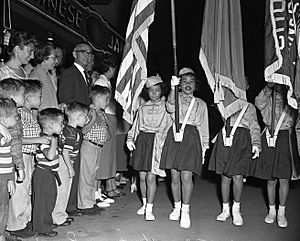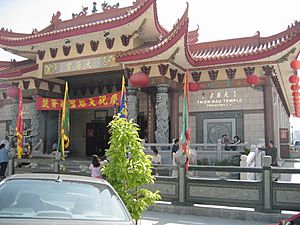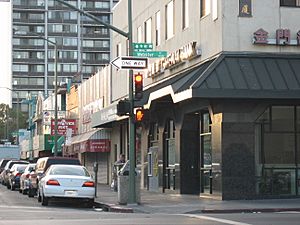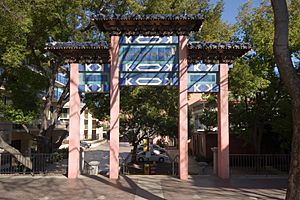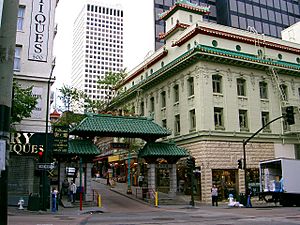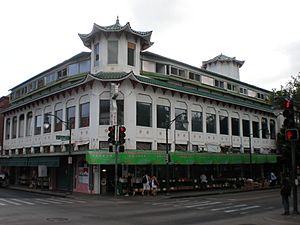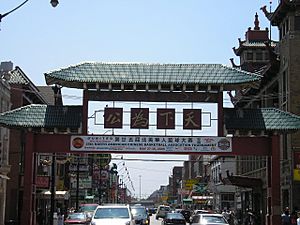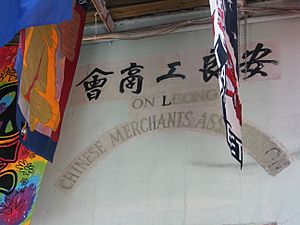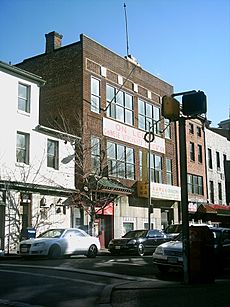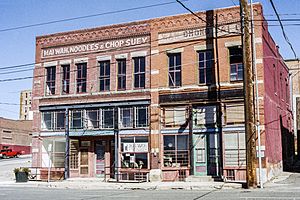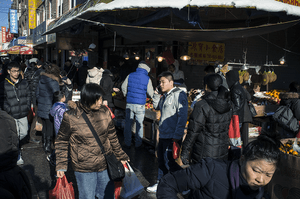Chinatowns in the United States facts for kids
Quick facts for kids Chinatown |
|||||||
|---|---|---|---|---|---|---|---|
| Chinese | 唐人街 | ||||||
|
|||||||
| Alternative Chinese name | |||||||
| Traditional Chinese | 中國城 | ||||||
| Simplified Chinese | 中国城 | ||||||
|
|||||||
| Second alternative Chinese name | |||||||
| Traditional Chinese | 華埠 | ||||||
| Simplified Chinese | 华埠 | ||||||
|
|||||||
Chinatowns are special neighborhoods where many people of Chinese background live outside of China. The very first Chinatown in the United States was in San Francisco in 1848. Many more Chinatowns appeared in the 1800s, especially on the West Coast, as Chinese people moved to America.
By 1875, Chinatowns also started in big cities like New York City, Boston, and Philadelphia. Later, a law called the Chinese Exclusion Act stopped Chinese people from coming to the U.S. for many years. But in 1943, this law was removed, and more Chinese people began to arrive, helping Chinatowns grow again.
Today, some old Chinatowns have changed a lot and are now popular places for tourists. Other Chinatowns are still home to many Chinese families. New York City, San Francisco, and Los Angeles have the largest Chinese populations in the U.S. The Chinatowns in New York City are some of the biggest Chinese communities outside of Asia.
Contents
- How Did Chinatowns Start?
- Where Do Chinese Americans Live?
- Chinatowns Across the United States
- California Chinatowns
- Colorado Chinatowns
- District of Columbia Chinatown
- Hawaii Chinatowns
- Illinois Chinatowns
- Louisiana Chinatowns
- Maryland Chinatowns
- Massachusetts Chinatowns
- Michigan Chinatowns
- Missouri Chinatowns
- Montana Chinatowns
- Nevada Chinatowns
- New Jersey Chinatowns
- New York City Chinatowns
- Ohio Chinatowns
- Oregon Chinatowns
- Pennsylvania Chinatowns
- Rhode Island Chinatowns
- South Dakota Chinatowns
- Texas Chinatowns
- Utah Chinatowns
- Washington Chinatowns
- Wyoming Chinatowns
- Images for kids
How Did Chinatowns Start?
Chinatowns in the United States have usually been in big cities like New York City, San Francisco, and Chicago. They first helped Chinese immigrants settle into American life. The oldest Chinatowns were mostly on the West Coast. Newer ones are now appearing in different cities.
Some smaller Chinatowns are changing as people move back to China or to other areas. Many city Chinatowns are now more about tourism than being a main home for Chinese families. However, the quickly growing Chinatowns in New York City's boroughs like Queens and Brooklyn are different. They are still growing fast because many people from mainland China continue to move to New York.
Here are some important times in Chinatown history:
- 1840s–1860s: Many early Chinatowns grew on the West Coast. This happened because of the California Gold Rush and the building of the Transcontinental railroad. San Francisco's Chinatown is a good example.
- 1882–1943: The Chinese Exclusion Act stopped Chinese immigration to the U.S.
- 1943: The Chinese Exclusion Act was ended. Chinatown populations started to grow again.
- 2010s: The U.S. economy slowed down, and China's economy grew. This caused some Chinese Americans to move back to China, and some Chinatowns became smaller.
Where Do Chinese Americans Live?
Most Chinatowns began as neighborhoods mainly for Chinese people. But over time, many have changed. Some still have a large Chinese population, while others have become more mixed.
Here are the top cities with the most Chinese-American residents, based on a 2015 survey:
- New York City (549,181 people)
- San Francisco (179,644 people)
- Los Angeles (77,284 people, plus many more in nearby areas like the San Gabriel Valley)
- San Jose (72,141 people)
- Honolulu (53,119 people)
- Chicago (51,809 people)
- San Diego (40,033 people)
- Philadelphia (35,732 people)
- Oakland (33,818 people)
- Houston (32,968 people)
Chinatowns Across the United States
California Chinatowns
California has the most Chinese people in the U.S. This is because it's closer to Asia. It has famous Chinatowns like the one in San Francisco, and even a town called Locke that was built by Chinese immigrants.
Los Angeles Chinatown
The Chinatown in Los Angeles was built in the late 1930s. It's located near Dodger Stadium. You can find restaurants, grocery stores, and shops for tourists there. A cool sculpture of two gold dragons marks the entrance. There are also Buddhist temples and Chinese Christian churches.
Oakland Chinatown
Oakland's Chinatown started in the 1860s. It's similar to San Francisco's Chinatown but not as focused on tourism. The streets have signs in both English and Chinese.
Today, Oakland's Chinatown is a mix of many Asian cultures, not just Chinese. You'll find Vietnamese, Korean, and Filipino communities there too. They celebrate Chinese New Year and also have an annual Streetfest in August with lion dances and food.
Sacramento Chinatown
In the 1840s and 1850s, many Chinese immigrants came to America because of wars and poverty in China. Some came to San Francisco, and then to Sacramento. They hoped to find a better life and gold.
Sacramento's Chinatown faced many challenges, including fires and unfair laws like the Chinese Exclusion Act. Newspapers sometimes wrote bad things about Chinese people. Over time, parts of Chinatown were torn down for new projects, and it became harder for Chinese workers to live there.
San Francisco Chinatown
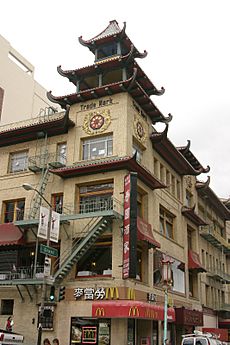
San Francisco's Chinatown is one of the oldest, largest, and most visited Chinatowns in North and South America. It started in 1848. After a big earthquake in 1906, it was rebuilt with a special Chinese-style look.
This Chinatown is a major tourist spot, attracting millions of visitors each year. It's a key part of San Francisco's history and Chinese-American heritage. You can find unique shops, a fortune cookie factory, and a recreation center.
San Francisco's Chinatown hosts the biggest Chinese New Year parade in North and South America. It's also known as the birthplace of chop suey and many other popular American Chinese cuisine dishes. While many Chinese Americans now live in other parts of the Bay Area, Chinatown remains a very important cultural center.
San Jose Chinatowns
San Jose once had five Chinatowns. Many of the early Chinatowns were burned down, possibly by people who didn't like the Chinese community. One area, known as "Heinlenville," was built with brick buildings and water pipes in 1887. It had shops, doctors, and a temple. This area got smaller over time, partly because of the Chinese Exclusion Act.
Colorado Chinatowns
Denver Chinatown
Denver, Colorado, once had a Chinatown on Wazee Street. It was also called "Hop Alley." Sadly, this neighborhood was destroyed by riots in the 1880s. A newspaper from 1880 described it as "Chinatown Gutted by Murderous Scoundrels."
District of Columbia Chinatown
Washington, D.C. Chinatown
Washington, D.C.'s Chinatown is a small, historic neighborhood. It has about 20 Chinese and other Asian restaurants and businesses. It's famous for its annual Chinese New Year festival and the Friendship Arch, a beautiful Chinese gate over H Street. The neighborhood is near the Verizon Center, a sports arena, and museums.
Hawaii Chinatowns
Honolulu Chinatown
The historic Chinatown in Honolulu started in the 1890s. Unlike many other U.S. Chinatowns, it was mainly founded by early settlers from Zhongshan, China. They came to Hawaii to work on sugar cane and rice farms, and later moved to Honolulu.
Today, Honolulu's Chinatown is very diverse, with many Asian and Pacific Islander businesses. You can find markets, bakeries, and shops selling traditional Chinese remedies. It's a lively place with bazaars and street vendors. The area has been improved and now mixes traditional Chinese markets with an arts district.
Illinois Chinatowns
Chicago Chinatown
The Chinatown in Chicago is a traditional neighborhood on the city's south side. It's a cultural tourist spot and also a place where many new Chinese immigrants settle. The annual Chinese New Year parade is held here. In recent years, many new homes have been built, increasing the number of people living in the area.
Louisiana Chinatowns
New Orleans Chinatown
New Orleans once had one of the largest Chinatowns in the Southern U.S. Chinese workers first came to Louisiana after the American Civil War, between 1867 and 1871, to work on farms. Many later moved to cities like New Orleans.
By the 1880s, a small Chinatown grew on Tulane Avenue. It had grocery stores, import companies, traditional medicine shops, restaurants, and laundries. This Chinatown lasted for 60 years until it was torn down in 1937 for new buildings. A smaller Chinatown later tried to start on Bourbon Street but also disappeared. Today, only one old building remains.
Maryland Chinatowns
Baltimore Chinatown
Baltimore, Maryland had a small Chinatown. The first one was on Marion Street in the 1880s. A later one was on Park Avenue, mostly with laundries and restaurants. The Chinese population in Baltimore never grew very large. Most Chinese residents moved to the suburbs after the 1960s. Today, the area doesn't look like a Chinatown anymore.
Rockville and Potomac Chinatowns
Rockville, along with nearby North Potomac and Potomac, has one of the largest Chinese communities in Maryland. Many Chinese families moved here for the good schools. Some people even call this area the "real Chinatown" because it has many authentic Chinese restaurants and newspapers.
After riots in Washington, D.C. in 1968, many Chinese families moved to the suburbs of Maryland and Virginia. This led to the growth of these new Chinese communities outside the city. The Chinese New Year parade is now held in Rockville Town Square.
Massachusetts Chinatowns
Boston Chinatown
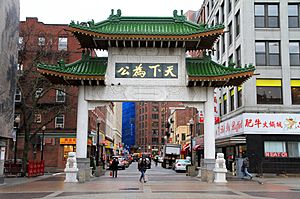
The only established Chinatown in New England is in Boston. It's located near South Station. This is the third largest Chinatown in the United States. You can find many Chinese, Japanese, Cambodian, and Vietnamese restaurants and markets here.
Boston's Chinatown was established in 1890. Before that, different immigrant groups lived in the area. Now, Boston's Chinatown is changing, with new tall buildings being built nearby.
Michigan Chinatowns
Detroit Chinatown
Detroit's Chinatown was first located in one area, but later moved in the 1960s. However, due to problems in the city, the new Chinatown also declined. The last Chinese restaurant in Chinatown closed in the early 2000s. Today, only a road sign and a mural remain to mark the old Chinatown. A small community center still helps new Chinese immigrants in the area.
Missouri Chinatowns
St. Louis Chinatown
St. Louis, Missouri, had a Chinatown called Hop Alley from 1869 until 1966. It was torn down to make space for a sports stadium. This Chinatown had many Chinese hand laundries, which were very common in the city. It also had grocery stores, restaurants, and tea shops.
Montana Chinatowns
The history of Chinese people in Montana is linked to the building of the Northern Pacific Railroad in the 1860s. In the 1870s, almost 2,000 Chinese people lived in Montana Territory. Today, one of the few reminders is the Chinese New Year parade at the Mai Wah Museum in Butte.
Butte Chinatown
The Chinatown in Butte is remembered at the Mai Wah Museum. Many Chinese workers moved to Butte during a mining boom and started businesses. There was some unfair treatment against Chinese people in the 1870s. Businesses fought back against boycotts and won. Butte's Chinatown became much smaller over time, with most Chinese people moving away by 1940.
Nevada Chinatowns
Carson City, Reno, and Virginia City Chinatowns
Carson City, Nevada once had a Chinese community of almost 800 people. This Chinatown was near the State Capitol buildings and burned down in 1908. In 1880, about one in five people in Carson City was Chinese. Other Nevada cities like Virginia City and Reno also had Chinatowns. Reno's Chinatown was burned down in 1878.
New Jersey Chinatowns
Newark Chinatown
Newark once had a Chinatown centered on Market Street from 1875. By the 1920s, it had over 3,000 Chinese residents. A small lane called Mulberry Arcade was built for housing and shops. However, police raids and other issues caused many people to move away. The center of Chinatown was removed in the 1950s.
New York City Chinatowns
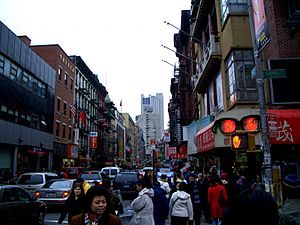
The New York metropolitan area has the largest Chinese population outside of Asia. It has at least 12 Chinatowns, with six (or more) in New York City itself.
The first Chinese immigrants came to Lower Manhattan around 1870. The Chinese Exclusion Act in 1882 slowed down immigration. But after 1968, when immigration rules changed, the Chinese American population grew very quickly. Today, the Mandarin Chinese language is becoming more common than Cantonese in many areas.
Manhattan Chinatown
The Manhattan Chinatown is home to the largest group of Chinese people in the Western Hemisphere. It's located in the borough of Manhattan. This Chinatown is always growing because many people from mainland China continue to move to New York.
Early settlers were mostly Cantonese speakers from Taishan and Hong Kong. Later, many immigrants from Fuzhou, China, settled in an area called "Little Fuzhou" within Manhattan's Chinatown.
Queens Chinatowns
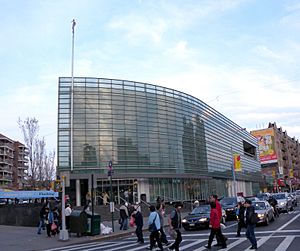
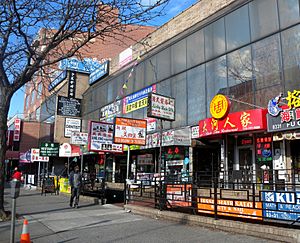
The Flushing Chinatown in Flushing is one of the biggest and fastest-growing Chinese communities outside of Asia. It started in the 1970s with Taiwanese immigrants, followed by other Chinese groups. Many different Chinese languages are spoken here, including Mandarin and Cantonese.
Flushing Chinatown is growing so fast that it might soon be larger than the original Manhattan Chinatown. Another neighborhood in Queens, Elmhurst, also has a large and growing Chinese community. Newer Chinatowns are also appearing in Corona and Whitestone.
Brooklyn Chinatowns
In 1988, Chinese immigrants began moving into the Sunset Park area of Brooklyn, looking for lower rents. This led to the creation of the Brooklyn Chinatown, which now stretches for 20 blocks along 8th Avenue.
While it was first settled by Cantonese immigrants, many Fuzhou immigrants have moved into Brooklyn's Chinatown. It is now home to a very large Fuzhou population. Other new Chinatowns are also appearing in different parts of Brooklyn, like Avenue U and Bensonhurst. The number of foreign-born Chinese people in Brooklyn grew a lot between 2000 and 2013.
Ohio Chinatowns
Cleveland Chinatown
Cleveland, Ohio, had a Chinatown that started in the late 1800s. Most Chinese people in Ohio lived in the northeastern part of the state. Cleveland's Chinatown was usually only one city block with restaurants, laundries, and specialty stores. Over time, especially by the 1960s, many Chinese Clevelanders moved to other neighborhoods as people became more accepting.
Oregon Chinatowns
Portland Chinatown
Old Town Chinatown is the official Chinatown of Portland, Oregon. It includes historic districts listed on the National Register of Historic Places. This area is a mix of Chinese, Japanese, and other Asian cultures.
Salem Chinatown
Downtown Salem had a Chinatown in the mid-to-late 1800s, but it disappeared by the 1920s. Ships from Hong Kong started arriving in Portland in 1868, and some Chinese immigrants settled in Salem. Salem's Chinatown had markets, laundromats, and medicine shops. Its Chinese population was highest in 1890.
Pennsylvania Chinatowns
Philadelphia Chinatown

There is a Chinatown in Philadelphia centered on 10th and Race Streets. Over the years, parts of it were lost to new buildings like the convention center. But now, Chinatown has grown back, expanding to new streets. You can find many Asian restaurants, funeral homes, and grocery stores here. People from different Chinese backgrounds, as well as Vietnamese, Thai, and Cambodian people, call Philadelphia's Chinatown home.
Rhode Island Chinatowns
Providence Chinatown
Providence, Rhode Island once had at least two Chinatowns. One on Burrill Street burned down in 1901. Another on Empire Street was considered one of the "last of the old Chinatowns" in the area. However, the expansion of Empire Street around 1951 led to the demolition of all its buildings, and the Chinatown disappeared.
South Dakota Chinatowns
Deadwood Chinatown
A Chinatown once existed in Deadwood, South Dakota around the mid-1880s. The Chinese community there was mainly made up of gold mine workers.
Texas Chinatowns
Houston Chinatowns
The city of Houston has two areas known as Chinatown. The older one is in East Downtown Houston, and the newer one is in Southwest Houston.
The first businesses in East Downtown Chinatown opened in the 1930s. It grew until many businesses moved to Houston's new Chinatown. The new Houston Chinatown started in 1983 and grew quickly in the 1990s. It's about 12 miles southwest of Downtown Houston and is very large. Some people want to call the new Chinatown "Asia Town" because many different Asian groups live there.
Richardson and Plano Chinatowns
The D-FW China Town shopping center is in Richardson because of its large Asian population. Chinese immigration to Richardson began in 1975. Most Chinese cultural groups in North Texas are based in Richardson and Plano. The Dallas Chinese Community Center in Richardson offers English classes and has many Chinese books. Many Chinese restaurants in the area are in Richardson and Plano.
Utah Chinatowns
Salt Lake City Chinatown
Historically, Salt Lake City, Utah had a Chinatown in an area called "Plum Alley." This community included Chinese people who worked in mining and on the transcontinental railroad. It lasted until 1952 and had laundromats, restaurants, and specialty shops.
Washington Chinatowns
Seattle Chinatown
Seattle's current Chinese neighborhood started around 1910. The Chinese population rebuilt along King Street after an older Chinatown area was torn down. Chinese investors built many important buildings for businesses and homes.
In the 1950s, Seattle officials called the area the "International District" because of its diverse Asian population, which included Chinese, Japanese, Filipinos, and Koreans. Later, Vietnamese immigrants also formed a "Little Saigon" nearby. There was some debate about the name, so the city officially renamed it the Chinatown-International District.
Spokane Chinatown
A good-sized Chinatown existed in Spokane for many years, starting when the railroad arrived in 1883. It was a network of alleys with Chinese businesses. The Chinese population gradually decreased, and the area was abandoned by the 1940s. All that was left of Chinatown was torn down for a big event called Expo '74.
Tacoma Chinatown
Tacoma, Washington once had an important historic Chinatown. However, in November 1885, angry white residents forced the Chinese population out and burned down Chinatown. Many Chinese people fled to Portland, Oregon, or Canada. The Chinese Reconciliation Park was created to remember this sad event and help with healing.
Wyoming Chinatowns
Wyoming had three Chinatowns between 1880 and 1927. All three disappeared by 1927, partly due to the Chinese Exclusion Act.
Almy, Evanston, and Rock Springs Chinatowns
Almy, Wyoming was the smallest of Wyoming's three Chinatowns. Evanston, Wyoming was the most diverse. Rock Springs, Wyoming was the largest. It was the site of the terrible Rock Springs Massacre, where many Chinese people died.
Images for kids
-
Hilton Square in San Gabriel, California
-
Atlantic Times Square in Monterey Park, California


